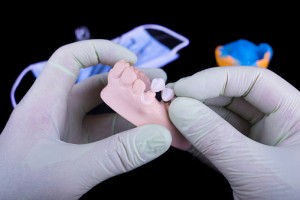Researchers Develop New Method for Creating Artificial Teeth
New method results in an excellent match for internal tooth structure, but not for appearance.

However, on a structural level, porcelain looks much different from tooth enamel. The natural structure of a tooth, including both enamel and dentin, actually consists of layers upon layers of micro-plates, which are perfectly arranged in alternating orientations and fused together. Up until recently, reproducing this complex structure was considered all but impossible by scientists.
Recently, however, a group of researchers from the Swiss Federal Institute of Technology in Zurich developed a new method that enables them to build artificial teeth that show the same structure under the microscope as natural teeth.
Their method is called “magnetically assisted slip casting.” First, the researchers created a plaster mold of the artificial tooth. Then, they filled the mold with a glass nanoparticle material containing a suspension of magnetized micro-plates. As the material hardened from the outside in during the casting process, it was subjected to a strong magnetic field, causing the micro-plates to align. By changing the orientation of the magnetic field at regular intervals, the researchers were able to reproduce the same pattern of layers found in a natural tooth.
The benefit of this method is that by reproducing the structure of enamel and dentin, artificial teeth with the same hardness and toughness of natural teeth can be produced. This is a great improvement over porcelain, which is often not advised for molars due to difficulty withstanding high biting stresses. Unfortunately, while the teeth are an excellent match on a microscopic level, they are not yet a good match to the eye. More work will need to be done to refine the process and improve the finished product before it can be used for crowns and other dental restorations.
Meanwhile, if you need a crown or other restoration, California Dental Group can offer you high-quality products made from tried and true materials, including porcelain and other ceramics. To make an appointment, please contact the clinic location of your choice today.




